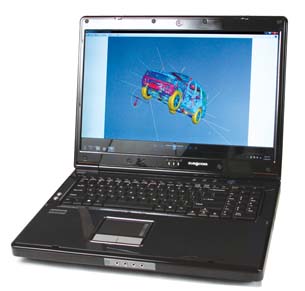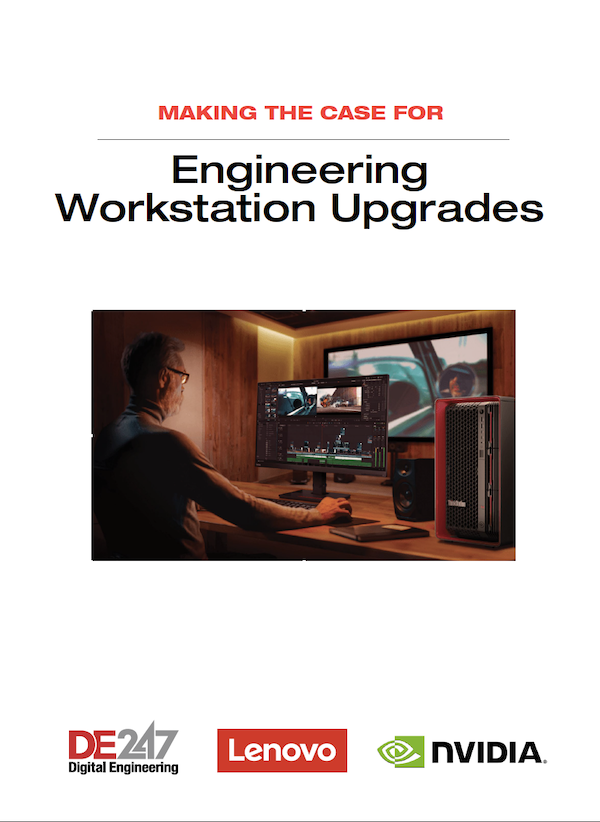Review: Eurocom D900F Panther Blows the Doors Off
The expensive Eurocom D900F Panther notebook outperforms most desktop workstations.
Latest News
December 4, 2001
By David Cohn
 |
While not a household name, Eurocom has been building some of the world’s most powerful portable computers for more than 20 years. The company offers lightweight notebooks and tablets, all-in-one portable desktop replacement notebooks, mobile workstations and mobile servers. When we first looked at one of the Canadian company’s systems five years ago, we were duly impressed. But the firm’s newest offering, its top-of-the-line Eurocom D900F Panther mobile workstation, blew us away. In fact, it delivers performance that beats most desktop workstations.
That may be because the Eurocom D900F Panther uses many components heretofore found only in true workstations—a blazingly fast 6-core Intel Xeon CPU, redundant array of independent disks (RAID) support, and triple-channel memory, all industry firsts.
Power comes at a price, however. This Panther may be fast, but it’s also big, heavy and very expensive.
The D900F measures 15.6x11.7x2.4 in., and tips the scales at 11.5 lbs., plus another 2.25 lbs. for its power supply.
Raising the lid reveals a 17.1-in. LCD with a native WUXGA resolution of 1920x1200 and a full-size keyboard with a separate numeric keypad. The touch pad, centered below the keyboard in the large wrist rest, seems a bit small in comparison, and has just a pair of buttons in addition to its dedicated scroll zone. Speakers are located to either side of the keyboard, and a pair of game keys below the left speaker can be assigned macros.
The round power button glows blue when the system is running, while three poorly labeled buttons to its immediate left activate email, a web browser and a user-specified application. LEDs arrayed above the keyboard indicate card reader and hard drive activity, number lock, caps lock and scroll lock status. Three more LEDs in the bezel below the display indicate power, battery and wireless status. The microphone is to the left of these, while an optional 3-megapixel camera is centered above the display.
 |
Lots of Expansion Options
The right side of the case is rather sparse, with just four USB 2.0 ports and a security lock slot. The left side is packed with an HDMI-out port, eSATA connector, a cable antenna jack, RJ-11 phone jack for the built-in modem, RJ-45 LAN jack for the built-in Gigabit Ethernet LAN, a mini-IEEE 1394 (FireWire) port, an ExpressCard slot, a 7-in-1 card reader, and the optical drive bay. Our evaluation unit came with an 8X dual-layer DVD +/-RW burner, but Eurocom also offers other drives with Blu-ray Disc read-and-write capabilities. Two more speakers occupy the front, along with an infrared transceiver and four audio jacks (line-in, S/PDIF-out, microphone and headphone), while the rear houses the power jack and a dual-link DVI-I port.
Like most Eurocom systems, configuring the D900F Panther is all about choices. The LCD is available with or without a non-glare coating, and you can also save a bit by going with a WSXGA+ (1680x1050) resolution display. Either way, the display can be driven by a choice of 10 different GPUs, ranging from an AMD Radeon or NVIDIA GeForce, up to a 2GB NVIDIA Quadro FX 5000M, which would add $1,711 to the base price. Our evaluation unit came with the excellent NVIDIA Quadro FX 3800M with 1GB of dedicated GDDR3 video memory, which was also able to power an external 30-in. monitor at up to 2560x1600.
You can also equip the Panther with any one of 24 different Intel processors. In our case, we pushed it to the limit: a 3.33GHz Intel Xeon X5680 CPU with 6 cores and 12MB of L3 cache. The system accommodates up to 24GB of memory in three 204-pin Small Outline Dual In-Line (SO-DIMM) memory sockets, two hidden behind the bottom panel (after removing no fewer than 26 screws, disconnecting several cables, and removing a cooling fan) and a third located beneath the keyboard. Our system came equipped with 12GB of memory using three 4GB DDR3 1333MHz memory modules.
Our evaluation also came with a 128GB Crucial Solid-state hard drive, which added $912 to the price, as well as a 500GB Seagate Momentus solid state hybrid 7,200rpm SATA drive with 32MB cache and 4GB flash memory. Eurocom offers solid state drives of up to 512GB and the D900F Panther can accommodate up to three internal hard drives, two in the primary drive bay and a third behind the 12-cell Li-Ion battery (which can be removed after loosening three captive screws).
That battery didn’t last long, powering the system for a bit more than 75 minutes in our battery rundown test. That’s actually more than we expected, but still useful as little more than an uninterruptible power supply (UPS). Don’t expect to venture too far from an A/C outlet.
Paying the Price for Performance
With all of the power packed into the Panther, we expected great performance, but we weren’t prepared for the results.
| Eurocom D900F Panther • Price: $7,467 as tested ($2,977 base price) • Size: 15.6 x 11.7 x 2.4 in. (W x D x H) notebook • Weight: 11.5 lbs. as tested, plus 2.25-lb. power supply • CPU: 3.33GHz Intel Xeon X5680 6-core with 12MB L3 cache • Memory: 12GB 1,333MHz DDR3 SDRAM (24GB max) • Graphics: NVIDIA Quadro FX 3800M with 1GB memory • LCD: 17.1-in. diagonal WUXGA LED (1920x1200) • Hard disk: 128GB SSD and 500GB 7,200 rpm Seagate Momentus hybrid drive • Optical: Multi DVD+/-RW dual layer • Audio: microphone, headphone, line-in, S/PDIF out, built-in microphone and speakers • Network: integrated Gigabit Ethernet (10/100/1000 NIC); Intel 802.11 a/b/g/n wireless LAN; optional integrated Bluetooth 2.0 • Modem: 56K V.92 • Keyboard: integrated 109-key keyboard with numeric keypad • Pointing device: integrated two-button touchpad • Other: four USB 2.0, one mini IEEE 1394 FireWire, eSATA, Express Card slot, 7-in-1 card reader, DVI-out, HDMI-out, 3MP webcam |
On the SPECviewperf test, which looks solely at graphics performance, the Eurocom D900F Panther outshined every other mobile workstation we’ve ever tested by a wide margin, sometimes as much as 40%. As if that wasn’t enough, its viewperf numbers also matched or beat every desktop workstation we’ve tested to date, with the exception of the over-clocked BOXX 3DBOXX 4860 Extreme (see DE, January 2011, page 14).
When we turned our attention to the SolidWorks benchmark, which is more of a real-world test and breaks out graphics, CPU and I/O performance separately, the Eurocom D900F Panther again beat out every other mobile workstation—and equaled or beat most of the towers we’ve tested.
With hyper-threading enabled, the equivalent of 12 CPU cores enabled the Panther to complete our AutoCAD rendering in less than 52 seconds. That’s nearly three times faster than the next-fastest mobile workstation, and faster than all but the most tricked-out desktop systems.
Of course, all of the Panther’s power comes with a staggering price tag attached. The standard D900F configuration sells for $2,977, although you can drop the price a bit by downgrading several components. Our evaluation unit was certainly not downgraded, however. As configured, the Eurocom D900F Panther we received would cost $7,467.
If that price isn’t daunting enough, the standard Eurocom warranty only covers the system for a year, and requires owners to ship the system back to a factory depot for repairs. Extending the warranty for a second year adds $145 to the cost, while adding a third year adds $259. But Eurocom does offer lifetime upgradability, as well as credits of up to 20% if you trade in an older system when purchasing a new Panther.
But if you’re an engineer, designer or graphic professional on the go who needs the ultimate performance in a portable package, the Eurocom D900F Panther can’t be beat.
More Info:
Eurocom Corp.
Advanced Micro Devices
Autodesk
Dassault Systèmes
Intel Corp.
NVIDIA
Seagate
David Cohn is the technical publishing manager at 4D Technologies. He also does consulting and technical writing from his home in Bellingham, WA, and has been benchmarking PCs since 1984. He’s a contributing editor to Desktop Engineering and the author of more than a dozen books. You can contact him via email at [email protected] or visit his website at DSCohn.com.
Subscribe to our FREE magazine, FREE email newsletters or both!
Latest News
About the Author
David Cohn is a consultant and technical writer based in Bellingham, WA, and has been benchmarking PCs since 1984. He is a Contributing Editor to Digital Engineering, the former senior content manager at 4D Technologies, and the author of more than a dozen books. Email at [email protected] or visit his website at www.dscohn.com.
Follow DE





